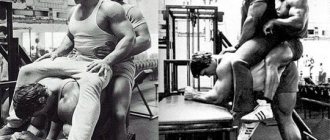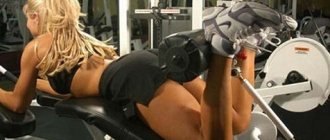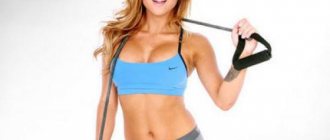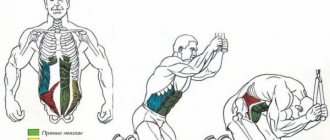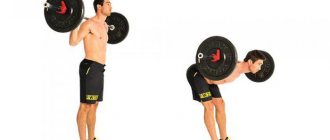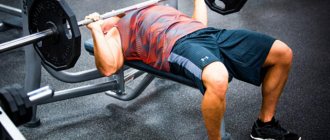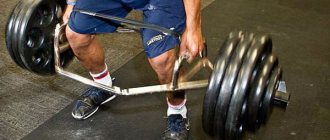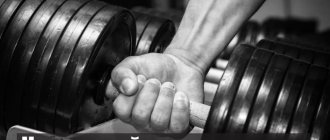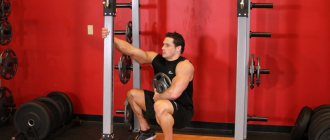Author: Timko Ilya - the ruler of the entire site and fitness trainer | more details >> Rod. 1984 Trained since 1999 Trained since 2007. Author and creator of the site tvoytrener.com. CCM in powerlifting. Champion of Russia and South Russia according to AWPC. Champion of the Krasnodar region according to IPF. 1st category in weightlifting. 2-time winner of the Krasnodar Territory championship in t/a. Author of more than 700 articles on fitness and amateur athletics. Author and co-author of 5 books.
Place in the author rating:
out of competition
(become an author)
Date:
2012-05-29
Views:
542,722
Rating:
5.0
| All articles by the author >> | Medals articles >> |
Articles are loading...
| Article medals: | article in TOP 100 | more than 500 thousand views |
Why medals are given to articles:
| Bronze medal: | |
| 1. The article is in the TOP 100 2. The article has more than 3. The article has more than 100 | |
| Silver medal: | |
| 1. The article is in the TOP 50 2. The article has more than 3. The article has more than 500 | |
| Gold medal: | |
| 1. The article is in the TOP 10 2. The article has more than 1 3. The article has more than 1,000 | |
Main muscles - biceps Additional - brachialis and brachioradialis muscles Difficulty - easy
Benefits and disadvantages of hammer exercises
- Despite the fact that the exercise develops the biceps muscles of the shoulder, thanks to its grip it also develops the forearms, the strength of which is necessary for all athletes who are constantly progressing in lifting heavy weights.
- This is an isolation exercise that makes the biceps more prominent and also trains the small muscles of the arms.
- Helps increase the volume of the arm due to hypertrophy of the brachialis.
- The hammer grip (neutral) helps strengthen and hypertrophy the forearm muscles. Compared to other dumbbell curl techniques, this is the most effective option for developing forearm muscle strength.
- It is an excellent exercise to include in a superset or triset.
- The exercise can be combined with barbell curls and dumbbell supination (rotation of the wrist). This will make the peak of the muscle more pronounced.
The disadvantage can be considered a less pronounced load on the short head of the biceps.
Biceps hammer exercise
Good day, everyone who has been brought to this site and who is interested in how to pump up hefty “cans”. This is exactly what we will talk about in this post, or more precisely, about one effective exercise that brings relatively quick results. This is a biceps hammer exercise. For those who didn’t know, biceps are just “cans”.
Wanting to have big biceps and having them are two very different things. For the second one, you need to work in the hall for more than one year, which is exactly what awaits you if you have never been there. Therefore, if you want to achieve something, you need to know what you are actually dealing with. The same applies to our goal. Therefore, first, a little theory.
What does “Hammer” train?
The fact that “Hammer” is an exercise for biceps was said at the beginning of the article, so why this subtitle above, you ask. Yes, a biceps is a biceps, but it does not consist of one solid muscle, there are several of them. This exercise simultaneously loads both heads of the biceps, both internal and external.
In addition, the brachialis is actively involved in the movement, which passes under the biceps muscle (biceps) and, gaining in volume, lifts it upward, thereby visually increasing the volume of the arm. The brachioradialis muscle is also developing well, this is the one located on top of the forearm. It is this muscle that gives the forearms a massive appearance.
In this way, with just one Hammer exercise, we develop several small muscle groups. Yes, it could even be called basic, if not for one, or even two, but the muscle groups are too small for basic exercises, and the execution technique implies movement in only one joint, so this exercise is isolated.
The difference between the Hammer and regular biceps curls
The main difference between the Hammer biceps exercise is the grip with which dumbbell lifts are performed. The grip is neutral - this means that when you hold the dumbbells, your palms should “look” at each other. Because of this, when performing the exercise, it seems as if you are working with a hammer, hence the name.
It is thanks to the grip, in conjunction with the correct technique, that it becomes possible to evenly distribute the load between both biceps bundles and actively load the brachialis with the forearm. With regular dumbbell bicep curls, this is more difficult to implement, since this exercise often turns from an isolated one into a basic one.
Because of this, deltas are loaded. And everything would be fine if they were loaded not by “stealing” the load. When doing the biceps hammer exercise, this does not happen, of course, if you follow the technique.
How to perform the Hammer exercise correctly
The hammer can be done both sitting and standing, lifting can be done either alternately or simultaneously
Personally, I prefer to do it standing while lifting dumbbells; in my opinion, it’s easier to control the technique and you can better feel how the muscle works, which is very important when concentrating. If we talk about technique, the algorithm for performing one approach is as follows
First you need to take dumbbells of a suitable weight so that you can do 8-12 repetitions. Having chosen the weight of the projectile, stand straight with your feet shoulder-width apart to maintain a stable position.
The back should be kept straight with a slight, natural arch of the lower back throughout the approach, this position should be maintained. Look straight ahead, don't turn your head. The elbows are in a fixed position on the sides of the body. Do not allow them to move back and forth - the mechanics of movement will not allow them to move to the sides.
Holding the dumbbells with a neutral grip, inhale and lift them up to shoulder level. Next, exhaling, lower the dumbbells down
Attention, just lower the dumbbells, don’t throw them, this, firstly, destroys the whole point of the exercise, and secondly, it will lead to injuries. Continue performing the exercise until the specified number of repetitions per set
The Hammer biceps exercise is very effective in increasing the mass and volume of the biceps. Therefore, if your goal is to pump up big arms, then for biceps the Hammer should definitely be included in the training program. And that’s all, I wish you every success, especially in sports. Come back often, there is still a lot of useful and interesting things on the site.
https://youtube.com/watch?v=HSFV91jbMYI
What muscles work when lifting dumbbells with a hammer grip?
- Biceps brachii muscle.
- Brachialis.
- Brachioradialis.
- Pronator teres.
When performing the exercise while standing, the following muscles are included in the work as stabilizing muscles: the abdominal muscles, in particular the oblique abdominal muscles, leg muscles, and the serratus muscles also work as auxiliary muscles.
Tips for implementation
- Don't rock your body. Our task is to lift the weight through the work of the arm muscles, and not to throw them with the help of the back and deltas. Plus, with this technique you can injure your elbows and ligaments. If you can't lift dumbbells without swaying your body, then reduce the weight.
- Keep your elbows close to your body. When lifting and lowering dumbbells, our main task is to monitor our elbows. They should always remain in one position and be pressed against the body. If we start to bring them forward, then the front delta comes into play and takes most of the load on itself.
- Stop the dumbbells at the lowest point. After you lower the dumbbells down, they will need to be stopped. This is done to avoid their swinging and lifting due to inertia.
- Extend your elbows fully. This technique will stretch the biceps and brachialis as much as possible. Thus making them a little longer and increasing the amplitude of the exercise.
- Don't bend your arms completely. Arm bending occurs somewhere ¾ of the maximum. This way we will avoid tearing off the elbows.
- Breathe correctly. Breathing is an integral part of any exercise. Be sure to exhale as you push, and inhale as you lower. This will help when working with heavy weights and strengthens the cardiovascular system.
Smooth movement.
Control the entire process of performing the exercise. Your task is to feel the work of the target muscles, and not to shoot quickly and go home.
Hammer grip dumbbell curl technique
The athlete's starting position will be as follows:
- The athlete must place his feet at shoulder level. The back should be strictly vertical. Hands with dumbbells, held with a neutral grip, are located on the sides along the hips. Elbow joints are straight.
- The movement begins as you exhale. The athlete bends his arms at the elbow joint, tensing the shoulder muscles (biceps). Please note that the elbow joints should not move during the entire exercise.
- The reverse movement should be performed while inhaling a little slower than the upward movement.
You can perform arm curls simultaneously (with both hands), or alternately.
Exercise technique
If, while performing hammers with dumbbells, you do not feel the isolated work of the target muscle groups, then you are doing something wrong.
Performing hammers with dumbbells while standing is as follows:
- Remove the dumbbells from the racks. Straighten them completely and keep them parallel to your body. The back is completely straight, the gaze is directed forward. Keep your elbows as close to your ribs as possible.
- Start bending your elbows and lifting the dumbbells up. The hands “love” a constant load, so the option of alternately lifting dumbbells is not entirely suitable for us here. Lift both dumbbells at the same time, or perform the planned number of reps with one arm first and then the other. This will reduce the number of repetitions in the set, since you will not rest for a second or two after each repetition, but the blood supply to the muscles will be much stronger.
- The next important point is the amplitude of movement. You need to bend your arms to approximately a right angle between the forearm and biceps. Lifting dumbbells is accompanied by exhalation. It is not necessary to do this strictly in a vertical plane. Turn your arms slightly inward, then the load will shift to the brachioradialis and small muscles of the forearm. If you turn your hands a little outward and press your elbows even closer to your body, your biceps will work more.
- At the top point, it is advisable to take a short pause and additionally statically tense the arm muscles. This simple technique will increase pumping. Of course, doing lifts in this style is much more difficult than without a pause. Be prepared to do 2-3 fewer reps than usual.
- Smoothly lower your arms down while inhaling. You should lower the dumbbells about twice as slow as you lift them. It is important not to relax your hands; you need to feel how the muscles stretch. At the bottom point, you do not need to fully straighten your arms, relax and linger. On the contrary, it is better to work without pauses and not even fully extend your elbows below. There should be at least ten repetitions in one approach.
Other dumbbell hammer variations—seated, incline, or Scott bench—are technically no different from regular standing hammers. They just provide more points of support, which will make it easier for you to keep your body stationary. This will reduce cheating and make the load more isolated.
How to replace the exercise
- The biceps exercise can be replaced by hammer curls in a crossover using a rope handle. This exercise can be done with one hand or two.
- Kettlebell curls also a great alternative to the hammer exercise, which maintains a neutral grip by keeping the arms at your sides. Read more about biceps curls with a kettlebell →
- Another effective exercise would be curling the arms with a barbell with a reverse grip .
How to avoid getting injured
When performing the “hammer”, you cannot cheat: throw weight using inertia. If you use this technique during isolated exercises, you risk causing injury to the working joint and tendons.
You can’t not only throw dumbbells at the top point, but also drop them at the bottom - in addition to the risk of causing injury to yourself, the athlete destroys the effect of the exercise done.
The hammer should be performed with smooth movements, feeling the muscle tension throughout the entire approach.
You cannot use excessive weight; at a minimum, this can lead to a decrease in the effect, and at a maximum, serious injury.
It would be a good idea to use special sports gloves to prevent injuries.
Common Mistakes
Not all athletes have the correct technique; beginners are especially vulnerable in this regard, prone to making some mistakes:
- The elbow is pressed against the body, and the load moves from the target muscles to additional ones.
- The athlete rises on his toes, which transfers the load from his arms and also threatens him with loss of balance.
- The body sways back and forth, which unfocuses the load and also compromises balance.
- Overestimating his capabilities, the athlete lifts too much weight, as a result of which the technique suffers and the effect is reduced to a minimum.
Useful tips: checklist
- During the approach, we fix the body and elbow motionless in order to maintain the load on the muscle being worked.
- The point of the “hammer” is that the brachialis additionally affects the biceps, but you can vary the load by turning your palms with dumbbells up or down.
- The Hammer works the forearm, increasing its strength and giving the arm power.
- If an athlete has chosen the option of simultaneously raising both arms, he must carefully monitor attempts to cheat on the part of the body, such actions must be stopped, and if this does not work, we change the method of performing the exercise or reduce the weight.
- By fully straightening the arms when lowering, the athlete additionally receives stretching and growth stimulation.
- Due to the inability to work correctly with too much weight, there will be a constant desire to throw the dumbbells up, which is undesirable to do due to the risk of injury.
- Like other isolation exercises, the hammer should be done at the end of the workout, when the muscles, joints and tendons are sufficiently warmed up.
- The position of the dumbbell in the hand should not change during the exercise; the uniform distribution of the load on the biceps and brachialis depends on this.
- You should train at the same pace: without rushing, without making sudden movements, but also without making unnecessary pauses.
- At the end of the approach, it is recommended to stretch the muscles being worked.
The “hammer” helps to increase the thickness of the arms, affecting both the biceps and the brachialis, which, developing evenly and synchronously, create an enhanced external effect. This exercise is suitable for both experienced athletes and those who have just embarked on the path of building a body. Moreover, the latter are recommended to include it in their training programs from the very beginning for maximum development of all muscle masses.
Recommendations
There are some nuances that will enhance the effect of the exercise.
For example, the more the palm is directed downward, the more load is placed on the brachialis.
- The exercise is most effective when performed in a superset or triset.
- The hammer is best included in the training process as the last biceps exercise. Execution scheme: three to four approaches, each of which is performed for eight to twelve repetitions.
- During drying or losing weight, you can increase the number of repetitions to twenty.
An example of using the hammer exercise in training for the back and biceps
- Pull-ups.
- Pull of the upper block behind the head.
- Rows in a lever machine.
- Barbell row to the waist.
The second stage of the training will be to perform exercises to develop the biceps.
There are several options for making a hammer:
- First. Seated barbell curls with a wide grip and hammer exercise.
- Second. We perform a triset: seated barbell curl + supinated dumbbell curl + hammer.
- Third. Superset: crossover curl with straight handle + hammer.
These options can be alternated by experimenting with them. You can mix methods and work with different techniques, for example, fixing the weight in a certain position and changing the speed of execution.
An example of using the hammer exercise in split training
You can also consider training antagonist muscles. This is true when performing a separate workout on the arm muscles, usually found in a five-day split. Read more about split training →
- Close-grip bench press + wide-grip seated barbell curl (superset).
- French press + standing dumbbell curl (superset).
- Crossover arm extension + hammer (superset).
Analysis of the exercise
Anatomy of exercise - which muscles work
- Target muscles: biceps brachii, brachialis.
- Auxiliary muscles: brachioradialis muscle (brachioradialis), pronator teres, static muscles - trapezius, stabilizers - back extensors and abs.
Advantages
- Working with dumbbells in the exercise allows you to supinate the hand and thereby increase the efficiency of the movement.
- Alternating lifts allow you to perform more repetitions per set.
- A more anatomical trajectory of movement than in the version with a barbell.
- When performing the exercise while standing, it is more convenient to supinate the hand - in a sitting position, the projectile often comes into contact with the hips.
Flaws
- Maintaining the target load on the biceps is much more difficult than when performing it while sitting.
- The use of dumbbells limits working weights (compared to classic barbell lifts).
Preparing for the exercise
To prepare for the exercise, do a general warm-up. Focus on developing the elbow joints of both hands. Before working sets, perform a lead-up set with light dumbbells.
Proper execution
- The shoulder of the working arm remains fixed. The movement is performed only by the forearm, which allows you to make the load more “directed”.
- The elbow joints should be close to the body - they do not spread to the sides and their forward motion is minimal.
- The work is carried out within the amplitude: at the top point the weight is raised to chest level while maintaining a vertical shoulder position, at the bottom point the elbows remain slightly bent.
- The brushes rotate gradually - as the projectile rises and falls.
- When performing dumbbell curls while standing, the body should remain stationary throughout the entire set, without bending forward or bending back. If you still cannot maintain a fixed, even body position, try doing the exercise while standing with your back close to the wall.
- The breathing technique can be either “generally accepted” (exhale with effort, inhale during the eccentric phase), or with holding your breath while lifting.
Errors
- Body swing.
- "Walking" elbow.
- “Simultaneous” turn of the brush.
- Lifting the dumbbell too high.
- "Breaks" in the hands.
Efficiency Tips
- At the top of the lift, when the bar is at chest level, force a short delay into the peak contraction.
- To achieve a more stable position, it is recommended to slightly bend your knees.
- In the standing bend version, some athletes resort to “non-standard” breathing techniques. Try holding your breath during the lifting phase of the exercise to achieve the necessary torso stability.
- To increase the intensity of your biceps work, use a serial version of curls - that is, perform the indicated volume of repetitions first with one arm, and then change your working arm.
- In some cases, the use of cheating is not only acceptable, but also necessary. “Moderate” assistance from the core in the last 1-2 repetitions allows you to load more and thoroughly finish off the muscle.
- It will be possible to increase the complexity of the exercise and thereby increase its effectiveness if you change the “center of gravity” of the projectile. Grasp the bar not strictly in the middle, but shift your grip towards the plate (towards your thumb).
Inclusion in the program
Alternating lifts are most often used after a base load - for example, heavy barbell lifts.
Since in this case dumbbell curls are aimed at isolated and targeted finishing of the biceps, the range of repetitions is selected appropriately - 12-15 repetitions in 3-4 approaches.
Contraindications
- If the ligaments, tendons or elbow joints themselves are damaged, lifting with dumbbells in most cases causes significant discomfort and is accompanied by pain. However, after waiting for complete recovery and in the future, without abusing weights and following the technique, you can use the exercise in your training.
- Supinated raises may also be undesirable for wrist injuries. Any options with a “static” position of the hand are more acceptable for such health problems.
How to replace dumbbell curls with standing biceps curls
A great way to replace dumbbell curls is with a pulley machine. A similar movement with standing supination can be performed on a lower pulley with a cable handle.

